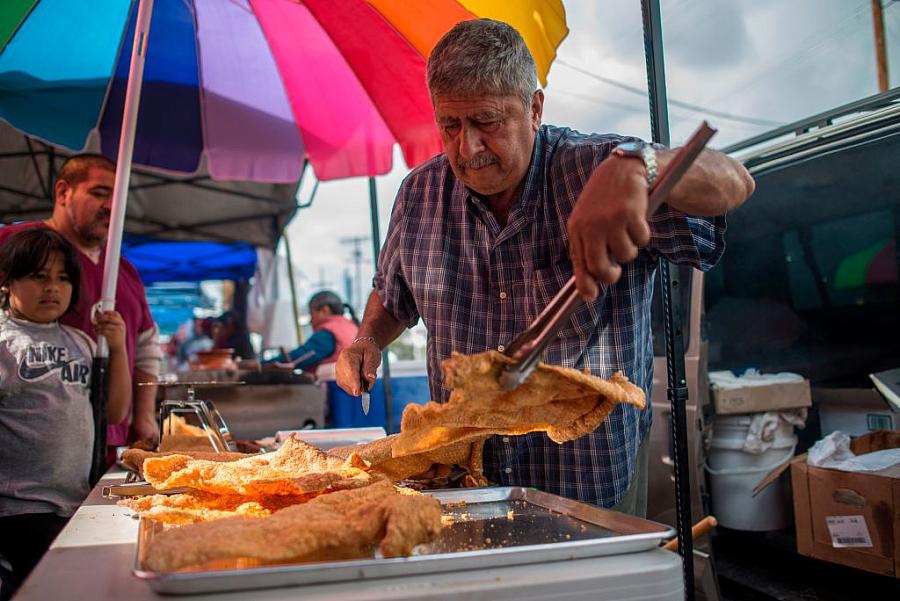Seven lessons for reporting on the overlooked plight of street vendors in a city near you

(Photo: Agustin Paullier/AFP via Getty Images)
After 150 years of criminalization, Los Angeles finally launched a program to permit street vendors in January 2020. But vendors could still not get their permits, because the health code asked them to use carts with instantaneous water heaters, three compartment sinks, 15 gallons of water, significant trash space and more. You even needed those sinks to slice fruit at your cart.
It was a story that warranted more coverage, and that fall my editors at Capital & Main partnered me with Janette Villafana at L.A. TACO to cover this story of street vending in the pandemic.
When COVID-19 arrived in Los Angeles, the City Council directed enforcement agencies to crack down on vendors. The Bureau of Street Services (BSS) still issues fines to vendors that can rise to nearly $1,000, and BSS employees inspect vendors with “less-than-lethal” firearms. When the Los Angeles County Department of Public Health inspects vendors, they often confiscate food and equipment. Vending inspections can spiral into arrests.
Over the summer of 2022, we used two grants from the USC Center for Health Journalism to survey vendors about their mental health. In early August, we hosted a forum on street vending and trauma attended by more than 40 vendors and a handful of representatives from California political offices.
Here are some lessons from the field for reporters covering street vendors in Los Angeles County.
Ask vendors what you should write about.
This will ensure your angle is not dictated by the media or by politicians. With street vending especially, there are large disconnects between government policy on paper and government policy as enacted on the ground. It’s not enough to ask the Bureau of Street Services for its current enforcement policy, or even for how many tickets they have issued to street vendors, because so much enforcement is not documented.
Get the details of how vendors’ run their businesses.
Street vending businesses are extremely complex, and each is unique. Vendors have to navigate a long list of hazards specific to their location, like a certain police officer who gives them an especially hard time or a brick-and-mortar restaurant that “taxes” vendors – demanding money in exchange for not calling law enforcement. Some locations or routes are more lucrative than others — ask them about that. It’s interesting. With one vendor we profiled this summer, Jose Luis Millan, we learned that he divides his time between three disparate and unique locations, including a route in Watts by the Imperial Courts housing projects that is most lucrative. He also sells in Palmdale, where the houses are more spread out and he swaps his pushcart for a bicycle. On Fridays, he sells to textile workers on their lunch break in a 20-minute frenzy outside their factory. It’s hotter in Palmdale, so raspados (shaved ice) outsell elotes (corn on a stick), but his ice purveyor is still in Watts, so he has to drive back and forth.
Write with a sense of history.
As documented by Los Angeles Times reporter Gustavo Arellano, the history of street vending criminalization in Los Angeles is almost as old as the city itself. As long as there have been street vendors in Los Angeles, business interests and racists have been trying to ticket, arrest or sweep them.
In the 1980s, street vending grew alongside Central American immigration to the city. Undocumented immigrants don’t have easy access to credit and can’t start businesses as easily as American citizens, so street vending is a safety net for many. As vending grew, so did enforcement. This brings me to my next suggestion.
File record requests for documents of enforcement. Search public databases for previous requests filed by other people.
As recently as 2012, the LAPD was arresting more than 1,000 vendors per year. I found that out because all record requests to the LAPD are posted online and I went looking for old requests related to street vending. These statistics are a window into the “old days” vendors speak about with a shudder, before vending was decriminalized in 2018, when SB 946 passed and cities launched their own permitting programs. But until SB 946, it was perfectly legal for cities to arrest people for selling fruit.
Ask the Department of Public Health for street vending inspections containing the phrase “all food condemned.”
That’s what health inspectors write when they throw out street vendors’ food. When they confiscate equipment, they write “all equipment condemned.”
Follow the money.
While vendors face significant opposition from individuals, business interests and tourist destinations have regularly advocated for criminalization or against legalization and are extremely well connected with elected officials.
Tourist destinations are particularly forceful advocates against street vendors because they see vendors’ as siphoning away profits from their own brick and mortar retail. There are seven “No Vending Zones” in Los Angeles, for instance, and all of them are at tourist destinations like the Hollywood Walk of Fame, the Hollywood Bowl or the Los Angeles Convention Center. At the Santa Monica Pier, a special police task force on unpermitted street vending has been regularly arresting vendors. It is the subject of several lawsuits.
7. Translate the article into Spanish.
Our sources really valued being able to read the final product and our work was republished in local Spanish language publications like La Opinión, which vendors read. As a journalist, you have access to elected officials, government agencies and other groups that vendors can’t reach as easily. It’s your responsibility to share what you learned about vending from the officials writing vending policy with the vendors themselves.

